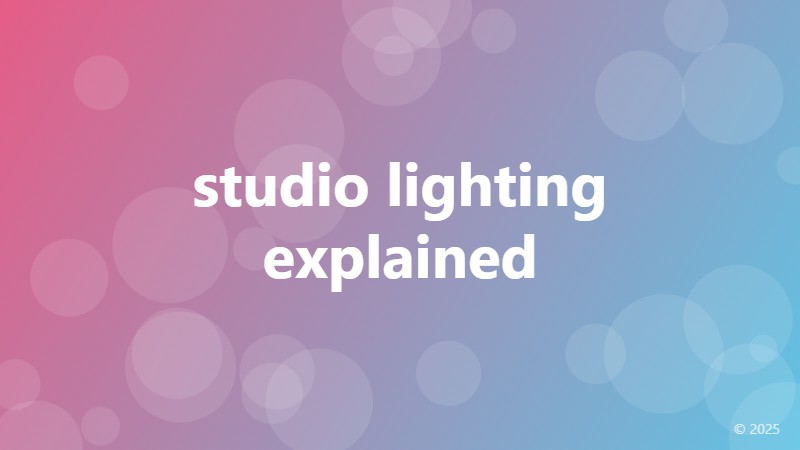studio lighting explained

Understanding the Basics of Studio Lighting
When it comes to photography, lighting is one of the most critical elements that can make or break an image. In a studio setting, lighting takes on a whole new level of importance, as it can greatly impact the mood, tone, and overall quality of the final product. In this article, we'll delve into the world of studio lighting, exploring the different types, techniques, and best practices to help you create stunning images.
Types of Studio Lighting
There are several types of studio lighting, each with its own unique characteristics and uses. The most common types include:
Continuous Lighting: This type of lighting provides a constant source of light, allowing you to see the effects of the lighting in real-time. Continuous lights are ideal for still-life photography, product photography, and video production.
Strobe Lighting: Strobe lights, also known as flash lights, emit a brief, intense burst of light. They're commonly used for capturing fast-moving subjects, freezing motion, and creating dramatic effects.
LED Lighting: LED lights are energy-efficient, cool to the touch, and provide a soft, natural light. They're often used for portrait photography, as they create a flattering, softbox-like effect.
Studio Lighting Techniques
Mastering studio lighting techniques is essential for creating high-quality images. Here are some essential techniques to get you started:
Three-Point Lighting: This technique involves using three lights to create a balanced, natural-looking lighting effect. The key light (main light source), fill light (softens shadows), and backlight (separates subject from background) work together to create depth and dimension.
Sidelighting: Sidelighting involves positioning the light source at a 90-degree angle to the subject, creating a dramatic, high-contrast effect. This technique is ideal for accentuating textures and creating moody, atmospheric images.
Backlighting: Backlighting involves positioning the light source behind the subject, creating a beautiful rim of light around the subject's edges. This technique is perfect for creating a sense of depth and separating the subject from the background.
Best Practices for Studio Lighting
When working with studio lighting, it's essential to keep the following best practices in mind:
Experiment and Adapt: Studio lighting is all about experimentation and adaptation. Be prepared to try different lighting setups and techniques to achieve the desired effect.
Pay Attention to Light Modifiers: Light modifiers, such as softboxes, umbrellas, and reflectors, can greatly impact the quality and direction of the light. Experiment with different modifiers to achieve the desired effect.
Work with a Color Temperature in Mind: Different light sources have different color temperatures, which can affect the overall mood and tone of the image. Work with a color temperature in mind to create a consistent, cohesive look.
By understanding the basics of studio lighting, including the different types, techniques, and best practices, you'll be well on your way to creating stunning, professional-quality images that showcase your unique vision and style.